If you are in the plumbing industry, you would have heard about the air gap faucet. The air gap faucet is a perfect choice for a plumbing device and aims to provide a siphon break in a reverse osmosis unit. Want to know more about the Air Gap faucet? Read on to learn more.
The air gap faucets are designed to prevent the backflow of water into your reverse osmosis unit. This is achieved with the introduction of the backflow prevention method, which is called an Air Gap. If anything clogs, only a small amount of water will go back into your system, and your system stays safer.
What Is An Air-Gap Faucet?
The air gap faucet is the plumbing system incorporated into the Reverse Osmosis drinking water systems. The RO systems are designed to send some water onto the drain. This is actually due to the fine nature of the reverse osmosis systems. The air gap faucet is designed to produce an excellent water supply for your needs. The RO system repeatedly washes the water itself and sends the impurities onto the drain.
The air gap faucet is a means of creating the physical siphon break from the RO itself and the sink drain.
What Is An Air Gap Used For?
The air gap faucet is also referred to as a reverse osmosis faucet. The air gap is used to prevent the backflow of the water into the reverse osmosis system. The method makes use of the air gap to stop the water from entering the RO system and directs it into the drain. In the plumbing language, an air gap is a vertical space (usually one inch or more) between the end of a pipe or faucet and the top of a nearby basin or sink.
The air ap technology is used for some of the plumbing requirements. The system is used for dishwaters and RO systems. The air gap is important to help you in preventing the backflow of the potentially contaminated water into the clean water supply. Without the use of an air gap, the wastewater will flow back into the drinking water supply.
How Do You Clean an Air Gap?
The air gap can accumulate debris and other materials. The formation of the clogs can be one of the serious concerns that can result in a blockage. You can use an air gap cleaning brush to clean the air gap.
The air gap can be visually inspected, and it can be done easily with the removal of the cap for visual inspection. If there is any debris, it can be easily removed with your fingers. If you cannot access it with your fingers, the best and right option would be to use an air gap cleaning brush for the purpose.
You can buy an air gap cleaning brush at the plumbing stores. They are also available at the DIY stores or even online. The air gap cleaning brushes are one of the excellent options for cleaning up the air gap with a few easy steps.
Should Water Come Out of The Air Gap?
No, under ideal conditions, the water should never come out of the air gap. The occasional water may be something that you may find quite common, but it should never happen on a regular basis.
When you notice the water leaking from an air gap, it is most likely due to the obstruction in the tube that goes from the air gap to the drain under the sink. To fix the water coming out of the air gap, you will need to clean the air gap. Cleaning the air gap is quite a more accessible option, and you can make sure the right tools to help you in stopping the water from the air gap.
The water coming out of the air gap can also be an indicator that shows a possible clog in the drain line. In any case, the water coming out of the air gap is not normal at all, and you will need to take the appropriate action to help you fix it.
Do You Need An Air Gap For Your Kitchen Faucet?
It is recommended to use an air gap in a kitchen faucet for the health reasons. Most of the plumbing codes will invariably require the air gap for the use in any RO system. The air gap is an essential part of the Reverse osmosis system and is designed to prevent the contamination of your water supply. The air gap faucet or the air gap in the RO system or any other similar appliances are used to prevent the contamination of the water that has already been filtered.
The RO systems generally supply the water through their own faucet, and many of the manufacturers design their RO systems with the air gap faucets inherent in the design. So ideally, you would need an air gap in your kitchen faucet if you have an under the sink RO system. Consult your local plumbing expert to discover the possibility of incorporating the air gap in the kitchen faucet.
How Does An Air Gap Faucet Work?
The air gap faucets are generally used on the under-sink reverse osmosis systems. These are used for practically every purpose that involves the use of clean drinking water. The air gap faucets are never used in the case of filters.
The air gap is an effective and efficient means of preventing the dirty drain water from flowing back into your clean drinking water. This is a backflow prevention and helps you avoid the possibility of mixing up of the impure water into the drinking water.
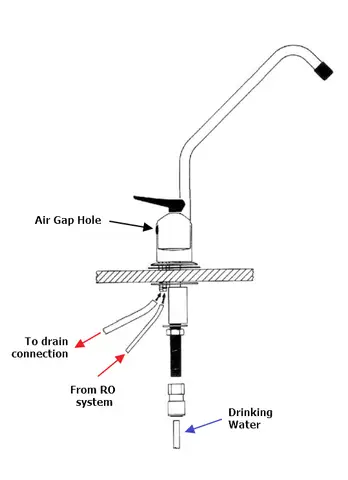
The air gap faucet has been used on several appliances that include your dishwasher, washing machine, water softener, or reverse osmosis system.
What is The Difference Between Air Gap and Air Break?
The terms air gap and ai break the two different methods of water technology. They are slightly different from one another but make a huge difference.
An air gap is a physical space created between the water outlet and the flood level of the plumbing fixtures. The air gap serves as the means of preventing the backflow of the contaminated water into the cleaner water supply. The air gap will ensure that the contamination is physically separated from the clean water supply.
In the case of an air break, it is a mechanism that prevent the siphoning of water from one location to another. This is done by introducing an air gap into the water flow path. This will help break the continuity of the water column and thus helps you in preventing the siphoning action.
The table here should provide you with an idea of the differences between the air gap and air leak:
| Air Gap | Air Break |
| Physical space between the water outlet and flood level rim | Mechanism to prevent siphoning of water |
| Prevents backflow of contaminated water into the clean water supply | Breaks continuity of water column to prevent siphoning |
| Used to protect the potable water supply from contamination | Used to protect water-using equipment from damage due to water hammer |
| Typically required by plumbing codes and regulations | It may be used in specific water supply applications, such as irrigation systems |
| Example: The air gap in a sink or bathtub drain | Example: An air break valve in a sprinkler system |
The Parting Thoughts
The concept of an air gap faucet has been a saving grace to help you prevent the contamination of the drinking water through the backflow of the impure water. The system is invariably used in the case of the appliances such as dishwashers, reverse osmosis, and similar other appliances. The discussion above should have helped you arrive at the best options to help you arrive at the best solutions.

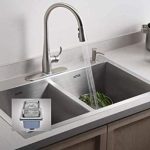

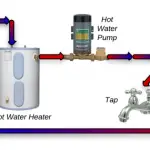
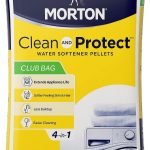
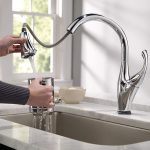





Add Comment